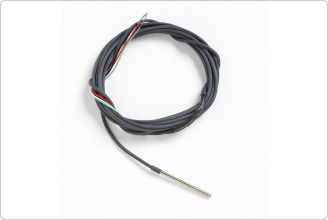PRTs for laboratory freezers, autoclaves, and furnaces
- 5606: -200 °C to 160 °C
- Calibration accuracy of ± 0.05 °C
- Transition junction and lead wires can withstand full PRT temperature range
- Unique probe seal of 5606 prevents ingress of moisture
- NVLAP-accredited calibration
The 5606 Full Immersion PRTs are designed to perform in extreme environments where both the transition junction and the lead wires are required to withstand temperatures covering the entire operating range of the probe. (“Immersion” in this case simply means exposure to temperatures other than ambient and does not necessarily refer to the medium to which the PRT and its components are subjected.)
Applications where “full immersion” of probe, transition junction, and lead wire is required can include calibration or validation of sensors used in laboratory or bio freezers, walk-in refrigerators, autoclaves, ovens, stability test chambers, furnaces or incubators. Other applications might include IQ/ OQ/PQ qualification procedures, temperature mapping, or data logging in temperature controlled spaces or environmental chambers.
The 5606 is just two inches (50 mm) in length with a sheath diameter of 1/8 inch (3.1 mm). Since it can be fully immersed over its entire temperature range, you don’t have to worry about calculating minimum immersion depth— immerse the entire probe, transition junction, and lead wires, in either non-corrosive liquids or dry mediums ranging from –200 °C to 160 °C.
The 100 Ω precision sensing element (alpha = 0.00385) is specially constructed to prevent the ingress of moisture while achieving calibration accuracies as good as ± 0.05 °C. You get both accuracy and flexibility built into a small, durable package.
The lead wires of the 5606 are made of single-conductor enameled copper wire which prevents moisture from wicking to the sensing element as it would if a more common, stranded lead wire were used. The diameter of the lead wire is no greater than 0.2 mm, making it easy to run lead wires through a freezer door to your readout or transmitter with effectively zero energy loss. The 5606 has been proven in common heat transfer fluids such as silicone oil, mineral oil, ethanol, and even liquid nitrogen with no degradation of the transition junction seal or lead wire insulation.
| General Specifications | |||
| Temperature range |
|
||
| Nominal resistance at 0.01 °C |
|
||
| Temperature coefficient |
|
||
| Accuracy[1] |
|
||
| Short-term repeatability[2] |
|
||
| Drift[3] |
|
||
| Hysteresis |
|
||
| Sheath length |
|
||
| Sheath diameter |
|
||
| Sheath material |
|
||
| Transition junction temperature range[4] |
|
||
| Sensor length |
|
||
| Sensor location |
|
||
| Minimum insulation resistance |
|
||
| Minimum immersion length |
|
||
| Maximum immersion depth in liquid medium |
|
||
| Response time[5] |
|
||
| Self heating (in 0 °C bath) |
|
||
| Lead-wire cable type |
|
||
| Lead-wire length |
|
||
| Lead-wire temperature range |
|
||
| Calibration |
|
||
[1] Includes calibration and 100 hr drift (k = 2).
[2] Three thermal cycles from min to max temp, includes hysteresis, 95 % confidence (k = 2).
[3] After 100 hours at max temp, 95 % confidence (k = 2).
[4] Temperatures outside this range will cause irreparable damage.
[5] Per ASTM E 644.
| Calibration uncertainty | |
| 5606 | |
| Temperature | 1924 Calibration Uncertainty† |
| -197 °C | 0.03 °C |
| -38 °C | 0.03 °C |
| 0 °C | 0.03 °C |
| 100 °C | 0.045 °C |
| 157 °C | 0.05 °C |
| † Lab code 200348-0 5606 meets ASTM E 1137 Grade A Classification of Tolerances. R0: Enter the R0 value provided |
|
| Model Name | Description |
|---|---|
| 5606-50-X |
Sonde, détecteur de température à résistance à immersion, 50 mm, –200 à 160° C X = borne. Spécifiez « A » (INFO-CON pour 914X), « B » (fil nu), « D » (DIN 5 broches pour thermomètres Tweener), « G » (broches en or), « J » (fiches banane), « L » (mini cosses à fourche), « M » (mini fiches banane), « P » (INFO-CON pour 1523 ou 1524) ou « S » (cosses à fourche). |
Accessories common to all models:
| Accessoire | Description |
|---|---|
| 2603 |
Étui de transport de sonde de petite taille |
| 1924-4-10 |
Étalonnage PRT |
| 1930-4-10 |
Étalonnage de système par comparaison, -200 à 157 °C |
Sidebar Request a Quote
Demander un devis



